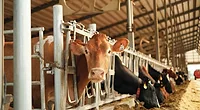Researchers Use Publicly Available WGS Data to Investigate AMR in Salmonella

Image credit: Sangharsh Lohakare via Unsplash
A recent study aiming to investigate the usefulness of publicly available whole genome sequencing (WGS) data for Salmonella surveillance has provided an overview of antimicrobial resistance (AMR) among different serovars and defined the most common antibiotic resistance genes.
Data for the study was downloaded from the European Nucleotide Archive (ENA) and was combined with metadata accessed through the U.S. National Center for Biotechnology Information (NCBI) Pathogen Detection Project. Out of 191,306 Salmonella genomes deposited in European Nucleotide Archive and NCBI databases, WGS data for 47,452 of S. enterica were retrieved, sourced from 116 countries and isolated between 1905 and 2020 (but 97.86 percent were isolated after 2001).
The final dataset of 47,452 Salmonella isolates was classified into 11 sources and 22 serovars. Salmonella genomes were isolated from human (29.1 percent), avian (22.5 percent), environment (11.89 percent), water (9.33 percent), swine (6.62 percent), bovine (6.49 percent), food (4.54 percent), plant (1.4 percent), feed (1.22 percent), nut and bean (0.33 percent), and other sources (5.72 percent). The top 10 common serovars were S. Enteritidis (13.84 percent), S. Typhimurium (12.04 percent), S. Newport (5.73 percent), S. Infantis (5.5 percent), S. Kentucky (4.55 percent), S. Muenchen (3.04 percent), S. Heidelberg (2.66 percent), S. Javiana (2.41 percent), S. Montevideo (2.38 percent), and S. Anatum (2.35 percent). Additionally, in human samples, the most common serovars were S. Enteritidis (8.54 percent), S. Typhimurium (4.5 percent), and S. Newport (2 percent), while in avian samples, the most common serovars were S. Kentucky (3.7 percent), S. Enteritidis (3.16 percent), and S. Infantis (2.76 percent).
To study the distribution of AMR among the Salmonella isolates, the researchers investigated the resistance in each class of antimicrobials from the WGS data. The results showed the percentage of AMR for aminoglycoside (98.39 percent), tetracycline (23.85 percent), folate pathway antagonist (18.63 percent), β-lactam (15.78 percent), phenicol (7.94 percent), fluoroquinolone (3.36%), polymyxin (1.18 percent) and macrolide (0.51 percent). The most common ARG profiles in Salmonella were β-lactam (blaTEM-1B), fluoroquinolone (parC[T57S], qnrB19), folate pathway antagonist (sul2), macrolide [mph(A)], phenicol (floR), polymyxin B (mcr-1.1), and tetracycline [tet(A)]. The researchers found the same resistance gene profiles in the U.S. as in other countries.
Looking for quick answers on food safety topics?
Try Ask FSM, our new smart AI search tool.
Ask FSM →









